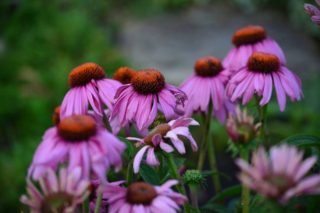Caring for Your Flower Gardens as the winter season approaches.
Fall is a winding down time in the garden, but it’s also a window where you can get a head start on next year’s gardening season. Get ahead of the curve now, so when spring fever hits, your to-do list will be a little shorter and your garden will be a little more orderly, healthy, and productive.
- Before the first hard frost, remove all annuals from your gardens. They can be put into the compost bin. Pulling weeds in the fall is a good idea. You’d be surprised if left to grow, that some weeds overwinter well and will be there next spring. Weeds should not be added to your compost bin.
- Clean up garden debris. Old leaves and flowers left lying in your garden can harbor overwintering insects and disease spores. Destroy any obviously diseased or infested materials. Do not add diseased materials to your compost bin.
- If your soil needs improving or you’d like to enhance the quality of your soil, adding compost, cow manure and or top soil and lightly working it into your soils in the fall is beneficial. These soil amendments have more time to break down and improve the soil structure of your gardens with a fall application. Also it is one less chore to do in the spring.
- Continue to water your perennials. Watering will not be needed as often as the summer months however it is beneficial to water throughout the fall up to the first hard frost. Keeping plant roots hydrated as they go into winter improves their ability to withstand cold winter temperatures and dry, harsh winter winds.
- Not all perennials need to be cut back in the fall. A general rule of thumb is to cut back spring / early summer blooming perennials in the fall and late summer blooming perennials in the spring. I would not cut back roses or hydrangeas in the fall.
- Cut perennials back when they turn brown, usually after our first hard frost. There are varying opinions on how far back to cut the perennials. Leaving 6-8 inches of plant stem on your perennials can provide more protection for the plant as it goes into winter. The extra stems help protect the plant crown from freezing. They also serve as markers come next spring to remind us where plants are located.
- Just a side note, some plants such as Black Eyed Susan’s, Coneflowers and Joe Pye Weed can be left standing all winter. The dried flower heads, leaves and stems of these plants provide food and shelter for various song birds.
- Mulch. If your summer mulch hasn’t broken down you may only need to add an inch or less of new mulch this fall. Otherwise, 2-3 inches of mulch added to your perennial beds in November helps conserve soil moisture. Plants need cool, fall temperatures to develop some winter hardiness so adding mulch later in the fall is better. Also mulch helps keep the soil temperature consistent and lessens the damage of heaving which occurs with fluctuations in winter temperatures. Heaving can break plant roots and severely lessen the plant’s ability to grow and flower the following spring.
- Last, do not prune your perennials too early in the fall. It is tempting when the temperatures are warm to go out and complete our pruning now. However, just as our plants bush out when pruned in the summer they will do so in fall if pruned too early and will actually start to produce new growth only to be killed by autumn frost. If you can, wait until late Oct or even after our first hard frost to prune your perennials for the winter.


